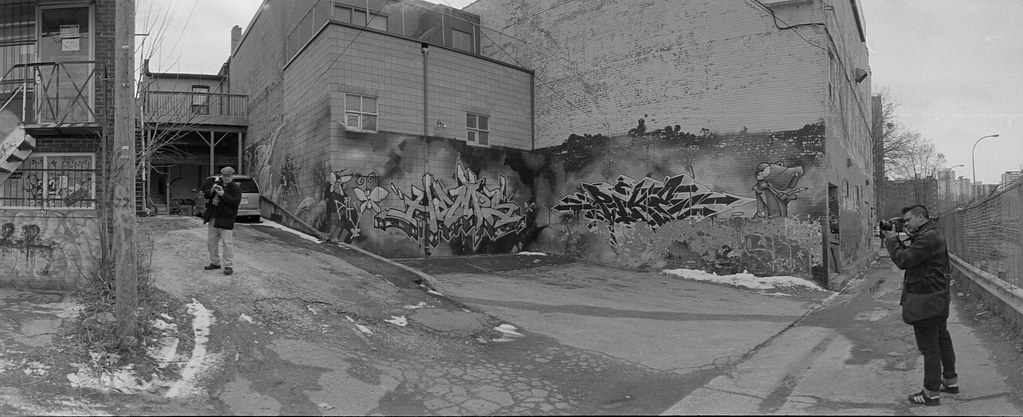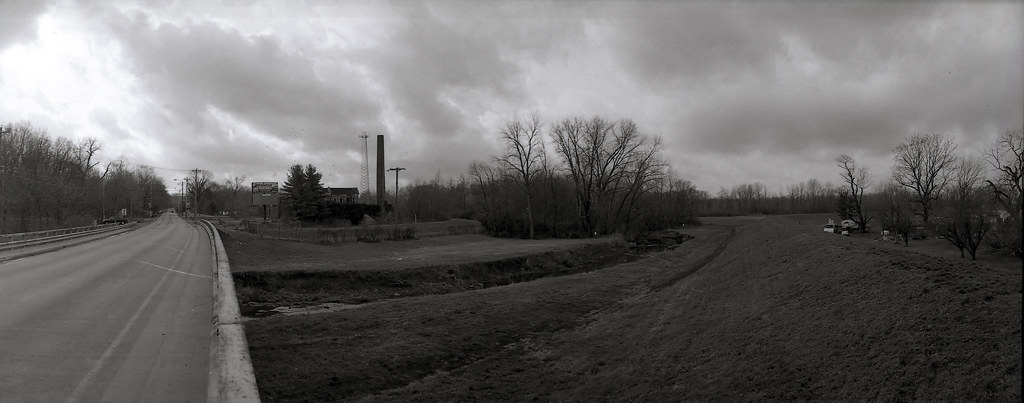I don’t remember what drew me to purchase the Horizon Kompakt; I had worked with the panoramic format before, but in the digital sphere, I stitched images together by shooting multiple frames to capture a unique take on an environment. But in 2011, I walked along Queen Street to a Toronto UER meetup, stopped in the Lomography Store (sadly closed), and picked up the Horizon Kompakt. In hindsight, I spent the extra money on the Perfekt. I immediately loaded up a roll of film (with the help of the store staff), went out, and shot through the roll. Well, I was hooked and hit the camera a lot throughout ownership. Sadly, the camera did not survive a move in 2017, and I haven’t been able to replace it since then because of the cost and availability issues.
Camera Specifications
Manufacturer: Lomography
Model: Horizon Kompakt
Type: Swing Lens Panoramic Camera
Format: 135 (35mm), 24x58mm
Lens: Fixed, Обьектив ИНДУСТАР MC 8/28 (Objective INDUSTAR, 28mm 1:8)
Shutter: Rotary Shutter, 1/60″ or 1/2″
Dimensions (WxHxD): 117x146x75mm
Weight: 650g
Year of Manufacture: 2005-2009(?)
Background
The idea of panoramic photography is as old as photography itself, with the first dedicated panoramic camera, the Sutton Panoramic, introduced in 1844. The Sutton created the panoramic image by exposing a wide plate, which was fairly awkward to operate, requiring multiple people to handle the plate itself. Another option that created panoramic photos is similar to how these images are produced today by using various images and then stitching them together. Besides using plates, photographers would expose multiple plates, lay them side-by-each and make a print from those plates to create the final image. While you could use a swing-lens-style panoramic camera to expose a wide plate similarly, the invention of flexible films would create a boom of panoramic cameras. These were mainly swing lens cameras and cameras that would rotate on a base. The first mass-produced panoramic swing-lens camera, the Al-Vista, hit the market in 1898, with Eastman-Kodak releasing their No. 4 Panoram camera a year later. Further swing lens cameras would follow through the early 20th Century and proved popular among amateur photographers as they could be used without needing a tripod or special equipment as they took standard roll film formats. While their popularity fell off through the war years, the post-war period and the rise in popularity of 35mm films would bring a new batch of panoramic cameras to the market.




The Soviet camera industry would dip its toes into the panoramic format 1948. Noted Soviet weapons designer Fedor Vasilievich Tokarev, known for his auto-loading pistols (TT-30 and TT-33) and rifles (SVT-38 and SVT-40), also designed the prototype Фотоаппарат Токарева (Fotoapparat Tokareva), or ФТ-1 (FT-1). The FT-1 was a simple box camera that used 35mm film and exposed a 24x110mm negative size. The camera never went into full production but was refined through the early 1950s by KMZ (Красногорский механический завод/Krasnogorskiy Mechanicheskiy Zavod) and in 1958 the FT-2 was introduced at that year’s Brussel’s Worlds Fair. The FT-2 maintained the 24x110mm frame size, which was exposed by an Industar-50 50mm f/5 lens with three selectable shutter speeds (1/100s, 1/200s, and 1/400s). The Model 1 FT-2 production lasted from 1958-1960, and a Model 2 from 1960 to 1968. Export models were branded as FT-2 in Latin characters or under Spiratone, Panorama and Spaceview. Production of the FT-2 ceased in 1968. Starting in 1967, a new panoramic camera hit the market from KMZ, the Горизонт (Horizont), which was a marked departure from the FT-2. The camera design followed the cues from the Widelux and Noblex model panoramic cameras. The Horizont came equipped with ОФ-28П (OF-28P), Objective-Industar 28mm f/8 lens, with three marked shutters speeds (1/30s, 1/60s, and 1/125s), an un-marked and uncalibrated speed of 1/250s also was available. On the export market, the Cyrillic text had been replaced by Latin characters, such as the Horizont Revue, Kalimar Wide-X and Global-H. Production of the Horizont ceased in 1973.




After the dust settled from the fall of the Soviet Union, production of a new panoramic camera started in 1991. Taking the original Horizont with a bold new design from V. Shablevich, the Horizon S202 looked like other modern SLRs from KMZ of the 1990s. The latest ABS plastic body and sleek design featured the same Objective-Industar 28mm f/2.8 lens and eight selectable shutter speeds between 1/2s and 1/250s. Later models replaced the lens with an MC Arsat 28mm f/2.8 lens, dropping the 1/15s and 1/30s speeds for smoother operations. Export models are branded as the Horizont 202, Horizon 202, Technopan-202, and Pan-35SL. Production of the 202 ceased in 2003, and the Horizon S3pro came as the replacement. The S3pro had an improved ABS body, a far more rounded appearance and improved mechanical functions for smoother and quieter operations. Lomography would take over the production of the Horizon cameras in 2005, moving production to China. Lomography would move the S3pro unchanged as the Horizon Perfekt and create a stripped-down version, the Horizon Kompakt, which used only two shutter speeds, 1/2s and 1/60s and no support for a spirit level or tripod socket. Production of the Perfeckt continues, but the Kompakt ceased in 2009.




Impressions
If you have ever worked or seen the Russian cameras from the 1990s, then the Kompakt will appear familiar. The clean lines and slightly boxy appearance are lifted directly from the older KMZ Horizon S202 and are a modern take on the original Horizont. Overall, the design and layout are simple, with basic controls, as the camera is pretty basic. For a camera of this type, it is surprisingly heavy as the internals are complex. But I will say that the camera looks super cool, with that front swing lens giving the camera away as a panoramic. The big wide viewfinder helps with composition, although it does lack the tripod socket and even a basic spirit level. Some of the controls, especially with winding knobs, felt weak, and ultimately that was where my copy failed. Also, the camera lacks the lugs to put a strap, which would have made the camera a lot more user-friendly.




Experiences
Despite being the simpler of the two Lomography Horizon cameras, the Kompakt could be a more user-friendly camera, and it is essential to get the functions demonstrated before getting started. The biggest hurdle to get over is loading your film. There is a specific method to loading your film that takes a lot of practice to get down, which is why I used the camera less often. Thankfully Lomography produced a video on the method for loading the film. Once the film is loaded, you’re ready to go and have some fun. The Kompakt exemplifies the Lomography idea of shooting from the hip; you’re set with a 28mm f/8 fixed lens, which has enough depth of field to capture everything; the biggest problem is that you are stuck with two shutter speeds, 1/60s or 1/2s, but with no tripod, the most significant thing when shooting is keeping your horizon level. In the end, you have to gear your film stock to the lighting conditions, but if you process your film at home, you can constantly adjust your processing to compensate for potential over or under-exposure. If you can look past the limitations, the Kompakt is a lot of fun to play with, and the images it produces are super weird; unlike more traditional panoramic cameras where the film lies flat long the plane, the curved film plane and swing-lens have some truly unique images that in the right place can be a lot of fun both in landscape and portrait orientation and that big 24x58mm negative size makes for big photos. At least rewinding and unloading the film is straightforward.




Optics
I’ve never been one to look down on Soviet Era optics, and the lens on the Kompakt is certainly no slouch. If I’m reading things online correctly, it is a glass lens that is based on the popular Tessar design. It is also multi-coated, which is essential for the wide angle. This lens also has a fixed aperture of f/8, which is more than enough depth of field for this camera. One of the best parts is that with the small aperture, you don’t have any issues with fall-off at the corners or vignetting. If you are seeing this, you have items in the frame that are out of focus. Any genuine problems with the lens are covered with the curved film plane that will sort out any quality issues. I don’t recommend shooting with harsh lights on the off-axis as it does tend to flare. The quality of a Lomography camera and lens is top-notch and not the typical toy camera lens you may expect from the company.




The Lowdown
It does not surprise me that the Horizon Kompakt was never a popular camera; the Perfekt is a far more capable camera for the cost of these cameras. Brand new, these cameras cost over 300$ Canadian, and the price on the secondary market has stayed close to that mark. Compared to the S202, the Kompakt is less of a camera, and if you are looking at the format, the Perfekt or an S3Pro is a better buy; even an older S202 would be a good choice. But you are again looking at prices around 300$. But this is cheap in panoramic cameras, as the Noblex and Widelux are going for $ 2,000$ or higher. These swing lens cameras are not comparable to the XPan and should not be in the same category. If these cameras are out of your reach but the format interests you, I would recommend going for the cheaper Sprocket Rocket, which is a more straightforward camera, but is no slouch in its own right. I do regret that my Kompakt broke, and I do admit I have looked at another similar camera, even the older Soviet-era models, but that price tag is the one thing that keeps me away.
Further Reading
Don’t just take my word on the Horizon Kompakt; you can check out the reviews by other awesome camera reviewers!
Lomography – Horizon Kompakt is Magic
PC Magazine – Lomography Horizon Kompakt Review

1 Comment